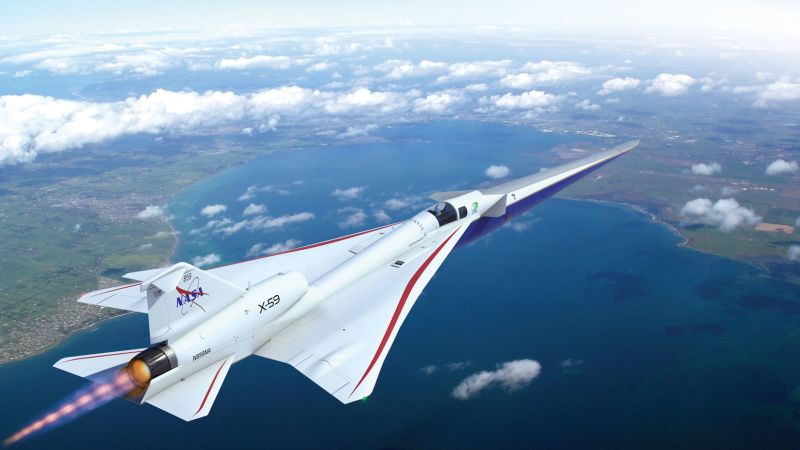In July, Lockheed Martin completed the build of NASA’s X-59 test aircraft, which is designed to turn sonic booms into mere thumps, in the hope of making overland supersonic flight a possibility. Ground tests and a first test flight are planned for later in the year. NASA aims to have enough data to hand over to US regulators in 2027.



america will do anything but invest in public transport huh
How about removed about the actual wasteful military spending instead of scientific research into physics and understanding the dynamics of sonic booms. Nasa has like .1% of the military budget ffs.
US defense budget was 752.9B for 2022, whereas NASA’s was 24.8B
So NASA’s funding amounts to 3.29% of the Defense budget (about 1/30)
https://www.defense.gov/News/Releases/Release/Article/2638711/the-department-of-defense-releases-the-presidents-fiscal-year-2022-defense-budg/
https://www.nasa.gov/sites/default/files/atoms/files/fy2022_budget_summary.pdf
I agree with you, but it’s nice to nail down the numbers
Airplanes are public transportation though
I mean ig but u know what I mean
trains, busses and shit
l
Are you going to ride the bus from NYC to L.A.?
Just because buses and trains don’t make sense for trans continental journeys, doesn’t mean they can’t be used for shorter journeys. There’s a bunch of areas in North America where is does make sense and could eliminate many flights.
That’s true. They’re talking about building a high speed rail from Portland to Seattle right now, and I think that would be awesome. Decades ago California spent billions to build a high speed rail from Fresno to San Francisco, which would have solved a lot of problems for both cities, but as far as I know, they never even laid a single mile of track.
nah but a high speed train
It would still take you 2-3 days, assuming normal operation with stops along the way. If the fastest train that exists on the planet right now ran from NYC to L.A. and was able to go from 0 to top speed instantly, and maintain that speed the entire trip, it would still take 10 hours to get there. Trains don’t operate that way though, so realistically it’s 3 days worth of travel. It’s almost 3000 miles to cross the USA.
There are technologies already starting to roll out which will make flying the least ecologically damaging means of public transport for long and medium length journeys, I wrote a comment about it already but they’re building a faculty that turns captured carbon into jet fuel it’s really clever stuff.
yeah but captured carbon gas is stupid expensive, and I imagine it’ll be worse for jet fuel. porsches recaptured carbon gas is like $40 a gallon
The first computers cost millions and the one I’m holding in my hand is basically worthlesss. capture and conversion are both fairly simple processes so we will see a lot of reduction in cost once engineering pathways are established especially when tied to excess power generation from renewables - instead of wasting excess capacity divert it to a nearby carbon capture plant.
If a system like this manages to make fuel cheaper than standard fuel types then we’ll see them spring up everywhere, it could be a total game changer. Worse ways there’s an expensive alternative for use cases where electric planes aren’t feasible and we learn a lot about atmospheric carbon in the process.
The air force have been doing studies and they’re really keen on it, fuel security is the main reason but it wouldn’t have got this far if it wasn’t at least somewhat economically viable.
I agree with you 100% that it will get cheaper, though I think that gas will soon be something only rich people can afford for their fancy cars. the rest of us peasants will be stuck with our shitty electric cars
Trans and busses and shit can cross oceans?
Use them where they make sense, they can still eliminate many flights.
Not with that attitude.
Public transportation is run by the State.
So there are very few countries where trains or buses are public transport?
Or it’s own people. Which is stupid, because the brain drain will catch up technology wise.
By investing into research of this airplane, the bulk of the costs are going to be manhours.
How is paying engineers going to cause brain drain?
We can tell it’s already effecting you by trying to suggest nasa is a waste, when we spend 100 times it’s budget on wasted military contracts or the fact we do have a tax bracket that allows someone to even become a billionaire instead of taking back excessive wealth stolen from workers in predatory labor markets. There are other areas we should be getting this money for the public and it sure as hell shouldn’t be from aeronautic or space research ffs.
that’s actually a very good point
Also NASA has created endless bits of research that benefit everyone and the economy, the fact I’m typing this from my phone is only really possible because NASA ‘wasted’ money going to space.
deleted by creator